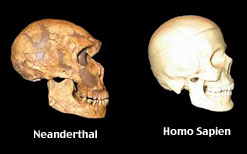Lets begin. . .
To begin, Marine Isotope Stages and Oxygen Isotope Stages are the same thing. These isotopes come from measuring oxygen in the microscopic skeletons of foraminifera
(forams, for short) that lived on the sea floor. This measure can be
used as an indicator of changing temperature and glacial ice over time.
There are two main trends: one toward an overall decrease in
temperature, the other toward a larger degree of climate fluctuation.
The amount of variability in environmental conditions became greater in
later stages of human evolution than in the earlier stages.
(Source: Smithsonian Institution. (2012). Climate effects on human evolution. Smithsonian National Museum of Natural History. Retrieved on November 15th, 2012, from http://humanorigins.si.edu/research/climate-research/effects)
(Source: Wikipedia. (October 13th, 2010). Pollen core. Wikipedia. Retrieved on November 15th, 2012, from http://en.wikipedia.org/wiki/Pollen_core)
Next, an Ice Core is a core sample that is typically removed from an ice sheet, most commonly from the polar ice caps of Antarctica, Greenland, or from high mountain glaciers elsewhere. As the ice forms from the incremental build up of annual layers of snow,
lower layers are older than upper, and an ice core contains ice formed
over a range of years. The properties of the ice and the recrystallized inclusions within the ice can then be used to reconstruct a climatic record over the age range of the core, normally through isotopic analysis. This enables the reconstruction of local temperature records and the history of atmospheric composition.
(Source: Wikipedia. (October 10th, 2012). Ice core. Wikipedia. Retrieved on November 15th, 2012, from http://en.wikipedia.org/wiki/Ice_core)
This article also offers fascinating insight to the process of obtaining and analyzing ice cores via the process of Paleoclimatology.
Lastly, Speleothems, commonly known as a cave formation, is a secondary mineral deposit formed in a cave. Speleothems are typically formed in limestone or dolostone solutional caves. Samples can be taken from speleothems to be used like ice cores as a proxy record of past climate changes. A particular strength of speleothems in this regard is their unique ability to be accurately dated over much of the late Quatenary period using the uranium-thorium dating
technique. Stalagmites are particularly useful for palaeo-climate
applications because of their relatively simple geometry and because
they contain several different climate records, such as oxygen and
carbon isotopes and trace cations. These can provide clues to past precipitation, temperature, and vegetation changes over the last ~ 500,000 years.
(Source: Wikipedia. (October 10th, 2012). Speleothem. Wikipedia. Retrieved on November 15th, 2012, from http://en.wikipedia.org/wiki/Speleothem)
For many years, people assumed that it was an overall superiority of modern humans: that modern humans were more intelligent, that they had better technology, or had more effective adaptations."They thought that when they came into Neanderthal regions, the Neanderthals very quickly disappeared, because they were out-competed. What we've learnt recently, is that the story was much more complicated. There probably wasn't a single cause of the Neanderthal extinction. They may have died out in different places for different reasons, but an exceptionally cold and variable climate might have driven the disappearance of Ice Age animals upon which the Neanderthals relied for food. In addition, climate change probably cleared Europe of its forests, creating an open environment that did not favour the Neanderthals.
(Source: Rincon, P. (February 13th, 2009). Did climate kill off the neanderthals?. BBC News. Retrieved on November 15th, 2012, from http://news.bbc.co.uk/2/hi/science/nature/7873373.stm)
How do they know this? Using the aforementioned climatic recreation tools (i.e. pollen and ice cores):
You can take any radiocarbon date from anywhere in the Northern Hemisphere and you can then map it on to the climate record of that particular site. So, for example, if you have a date of 24,000, you go down the core and say 'where do I get 24,000 radiocarbon years in that core' and then you see what the climate was doing - it's as simple as that.
(Source: Rincon, P. (February 13th, 2009). Did climate kill off the neanderthals?. BBC News. Retrieved on November 15th, 2012, from http://news.bbc.co.uk/2/hi/science/nature/7873373.stm)
This technique is how scientists know there was an unusually cold spell. It is now known as the Heinreich 2 Event. I know what you're thinking to yourself: Neanderthal morphology tells us that they were adapted for the cold weather, though? This is true, but it is thought the Neanderthal's inability to adapt their hunting and living methods to drastic swings in the climate ultimately led to their extinction. Europe suddenly became a barren steppe land, and Neanderthals were thought to have largely been hunting woodland animals.
So why didn't Homo sapiens go extinct when this happened? In my discussion of lithics, I mentioned that Homo sapiens had vastly increased the size of their tool kit, through making more refine and slender microliths. This allowed them to occupy a much larger ecological niche, and broaden the types of foods being eaten and hunted, than the Neanderthals (who still largely used traditional Mousterian tools). These facts, coupled with a string of major volcanic eruptions 40,000 years BP which affected large portions of Europe, is most likely what sealed the Neanderthal fate.
The Neanderthals may have gone extinct, but they leave behind a vast legacy of innovation, and they continue to teach us about how we came to be truly modern Homo sapiens. I leave you with a two part documentary produced by the Discovery Channel, that highlights the accomplishments, lifestyles, technological advancements, and hardships that the Neanderthals endured. Enjoy!







